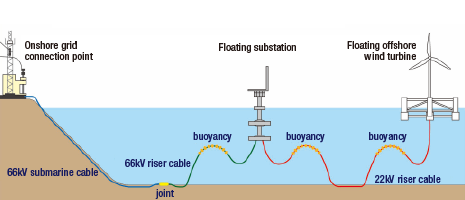Home > Highlighting JAPAN > Highlighting Japan September 2016 > Japan’s Fight Against Global Warming
Highlighting JAPAN


The World’s Largest Floating Wind Farm
A demonstration project of floating wind power generators is underway off the coast of Fukushima Prefecture.
Renewable energy projects are underway to support restoration efforts in Fukushima Prefecture, which was badly damaged by the Great East Japan Earthquake of March 2011. One of these projects is the Fukushima Floating Offshore Wind Farm Demonstration Project, which is being carried out about twenty kilometers off the coast of this prefecture.
The most significant feature of the project is its floating wind farm. Offshore wind turbines are quite common in Europe, but they are bottom-mounted with the wind power generation equipment fixed to the seabed. In Japan, waters quickly become deep offshore, so there are not many places suitable for the bottom-mounted model. Hence, the decision to use floating wind turbines.
The potential for offshore wind power generation is very high in Japan. According to a report by the Ministry of the Environment, the potential for offshore wind power generation (the volume of theoretically calculated usable energy) is estimated to be about 1.6 billion kW, ten times that generated by solar power. This figure is about eight times as large as the capacity of the current power facilities owned by the top ten power suppliers in Japan.
In particular, wind is constantly blowing at a speed of seven meters per second on average yearly off the coast of Fukushima Prefecture, which makes it the perfect location for wind farming. However, two currents intersect there with high waves and fast currents. There is no global precedent for introducing floating wind turbines to such a tough natural environment.
The project, which was funded by the Ministry of Economy, Trade and Industry, was launched in March 2012 by a consortium of eleven companies and organizations, including the University of Tokyo, Marubeni Corporation, Mitsubishi Heavy Industries, and Hitachi. In November 2013, just one and a half years after the start of the project, the Fukushima Mirai (2 MW), the first wind farm facility, began operations.
“Many people at home and abroad were surprised by the incredibly short period of time in which the wind power generation facility began operations,” says Assistant Professor Atsushi Yamaguchi at the School of Engineering, University of Tokyo, who is a project member. “The sight of floating offshore wind turbines made me think that we successfully achieved our dream.”
Subsequently, the Fukushima Shimpuu (7 MW) was constructed in September 2015 and the Fukushima Hamakaze (5 MW) was constructed in July 2016. The three facilities are capable of generating a total of 14 MW of power and have become the world’s largest floating wind farm.
The three facilities are located offshore from north to south, in waters about 120 meters deep, with a distance of about 1.5 kilometers between each. For the Fukushima Shimpuu, the largest of the three, wind turbines with three blades about 82 meters long sit on a floater. It is 188.5 meters from the surface of the water to the highest point of the wind turbine. The floater is anchored to the bottom of the sea by eight chains that are each about 13 centimeters in diameter so that it will not drift away in the strong winds and currents.
The Fukushima Kizuna, a substation, floats about two kilometers offshore from these wind power generation facilities.
The Fukushima Kizuna is a power transmission facility that transmits the electricity generated by the wind power generation facilities to land. It is the first floating power transmission facility in the world.
Power transmission cables called riser cables connect the three wind power facilities to the Fukushima Kizuna, which transmits the electricity to land. The riser cables (66 kV) are designed to move with the floating facilities, waves and currents, and they float underwater to avoid sustaining damage from friction with the seabed. It is also the first time in history that these cables with such large capacity have been installed at sea.
Currently, only the Fukushima Mirai is generating power, but if the three facilities begin simultaneous operations at the beginning of next year, they will be able to provide for the power needs of about 10,000 households. The University of Tokyo plans to construct a large-scale wind farm that is capable of generating a total of one million kW of power using 200 offshore wind power generation turbines in 2025 and beyond. If this plan is successfully implemented, Fukushima Prefecture will see the formation of an agglomeration of factories and research facilities as a major base of wind farms with the creation of jobs to operate, maintain and revitalize these facilities. This will ultimately make a major contribution to the restoration of the prefecture.
“There is little global data on floating offshore wind farms and we have many things to research, such as durability and security,” says Researcher Shigeru Taki from the School of Engineering, University of Tokyo. “We hope to make the project a global model by accumulating knowledge through repeated trial and error.”
© 2009 Cabinet Office, Government of Japan







